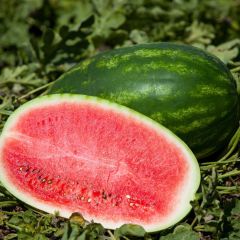
Watermelon: sowing, planting, growing, harvesting
Contents
Watermelon in a nutshell
- Watermelon is a vegetable-fruit of the family Cucurbitaceae, highly prized in summer for its refreshing, sweet flavour.
- To produce good fruit, watermelon needs a long period of heat and sunshine, more than melon.
- Its cultivation is preferable in the Midi of France; further north, it is recommended to grow it in a greenhouse.
- It is sown from mid‑March in a bucket and kept warm, to be planted in the garden after the last risk of frost in mid‑May.
- Watermelon is harvested from July or August and produces new fruit for about two months.
A word from our expert
Watermelon is a refreshing, thirst-quenching vegetable-fruit of the family Cucurbitaceae, cultivated before the Common Era in the Nile valley, as shown by frescoes in pharaohs’ tombs. It is a vegetable very demanding of heat, sun and water: that is why in France it is mainly produced in PACA and in Occitanie. While it is easier and recommended to grow it in these regions, it also grows further north. In these more temperate regions, it is recommended to grow it under glass or to choose better-adapted varieties such as ‘Premier Rayon de Lune’ and ‘Sugar Baby’. If not, do not hesitate to try ‘Charleston Grey’, with large fruits that can reach 15 kg, or ‘Crimson Sweet’, a variety resistant to two common cryptogamous diseases and with fruits weighing up to 10 kg.
Another requirement common to the family Cucurbitaceae, the soil must be rich in organic matter to produce healthy young plants and large fruits. A light soil, preferably sandy or silty, is preferable; it should be kept cool for optimal growth of the young plants. Preferably, obtain your young plants from seeds sown from mid-March indoors and in warmth. The young plants obtained are transplanted into the garden after risks of last frosts. First fruits will be harvested in July in the most southern regions, and in August further north.

Description and botany
Botanical data
- Latin name Citrillus lanatus
- Family Cucurbitaceae
- Common name Watermelon - Water melon
- Flowering Annual
- Height 5 years on average (sometimes up to 10 years)
- Exposure Sun
- Soil type Rich, loose, deep, cool in summer
- Hardiness 0°C
Watermelon is a plant native to Africa, it was cultivated before the Common Era in the Nile valley, as shown by frescoes in pharaohs’ tombs. From the Nile it spread to various regions along Mediterranean shores. It was not until the 19th century that explorers first discovered wild watermelons occupying large areas in central Africa. It was thus cultivated in southern regions of Russia, in Asia, and in the Near and Middle East.
Watermelon, Citrillus lanatus, is an herbaceous annual plant of the family Cucurbitaceae.
Three types of watermelon are distinguished:
- Bitter-fleshed watermelons, grown for seeds to roast.
- Jam watermelons, or gigérines, with white unsweetened flesh, red or green pips, edible only when cooked.
- Sweet-fleshed watermelons, eaten raw for their sweet red or yellow flesh.
Watermelon is a plant that produces creeping stems which can extend for several metres. Presence of tendrils enables the plant to cling to supports and grow vertically. Leaves, triangular, are lobed and smaller than those of melon and other squashes. Plant is monoecious, that is a young plant bears both male and female flowers. These form pale yellow corollas. The fruit, botanically speaking, is a berry which, depending on variety, is spherical to more or less oblong in shape, uniformly green or marbled, variable in size and with an average weight of 3 to 4 kg, and with flesh colour yellow or red.
With regard to pollination, the flowers are entomophilous; insects, especially bees, transport pollen between male and female flowers. Cross-fertilisation predominates, although a plant can self-fertilise. Seedless watermelons are triploid varieties produced by forced cross-breeding that yield sterile varieties, since they lack pips.

From left to right: Corolla of the 5-petalled watermelon flower – A male flower – A female flower – A young watermelon developing – A watermelon close to ripeness – Watermelon seeds in the flesh.
Watermelon varieties
Here is our selection of different watermelon and gigérine varieties (used for jam). My advice: opt for small-fruited varieties if you grow in a region north of the Loire.

Citrullus lanatus Crimson Sweet Bio
- Flowering time June to September
- Height at maturity 30 cm

Citrullus lanatus Charleston
- Height at maturity 60 cm

Citrullus lanatus Sugar Baby
- Flowering time June to October
- Height at maturity 60 cm

Citrullus lanatus Valentina, La Dolcissima
- Flowering time June to October
- Height at maturity 60 cm

Citrullus lanatus Sugar Baby - Vilmorin Seeds
- Flowering time June to October
- Height at maturity 60 cm

Organic Watermelon for Candying Green Flesh - Ferme de Sainte Marthe seeds - Citrullus lanatus
- Flowering time June to October
- Height at maturity 60 cm
Discover other Watermelon Seeds
View all →Available in 1 sizes
Available in 1 sizes
Available in 1 sizes
Available in 1 sizes
Available in 1 sizes
Available in 1 sizes
Available in 1 sizes
Available in 1 sizes
Sowing watermelon
Where and when to sow watermelon?
Watermelon can be sown across mainland France, except in climates that are too cold, such as mountainous areas. It produces better fruit in southern France but can also crop well north of the Loire when grown under glass.
Watermelon is sown by raising young plants in warmth, in a bright room in the house or in a greenhouse at above 20 °C for good germination. These young plants will be transplanted to the garden later. Watermelon can also be sown directly in open ground in warm climates.
Watermelon is sown:
- from mid‑March to late April in pots or buckets and kept warm.
- from late April to late May directly in open ground.
How to sow watermelon?
Raising young plants :
- Fill pots or buckets with a special sowing compost.
- Place two seeds per bucket, pressing them down to a depth of about 1 cm and cover with compost.
- Carry out an initial watering.
- Keep in warmth and light (on a windowsill), at a temperature of about 20 °C and keep the substrate moist until emergence.
- When the first two true leaves (cotyledons do not count) are well developed, thin out, keeping the strongest of the two young plants or separate the two young plants and repot them into individual buckets.
Direct sowing in place :
- Sow in hills of 2 to 3 seeds, pressing them down to a depth of about 1 to 2 centimetres.
- Allow one metre between future young plants in all directions.
- Carry out an initial watering
- When the young plants are sufficiently developed, thin each hill, keeping only the strongest young plant. You can optionally transplant the thinned young plants elsewhere if they are robust enough!
Planting watermelon
When to plant watermelons?
Watermelons are planted from mid-May, after the Ice Saints in regions most sensitive to frost. Planting can take place earlier in some areas, such as the Midi, depending on weather conditions that year. Planting period can extend until end of June.
How to plant watermelons?
Watermelons prefer to find a nutrient-rich soil and need a lot of warmth to set fruit well. They therefore require a site that is both very sunny and sheltered from cold winds.
Space plants 1 m apart in all directions.
To plant your watermelons successfully:
- Prepare a planting hole to same depth as root ball.
- Place young watermelon plant and backfill with soil; collar must not be buried.
- Firm soil lightly, then make a small basin around the young plant to concentrate watering at the roots.
- Water using the spout of a watering can after planting.
Cultivation, care and companion planting
Watermelon prefers soil kept cool at all times, rich in organic matter and light. It will perform better in soil with a sandy or silty texture. Watermelon requires about 3 kg/m² of well-rotted compost.
As it likes cool soil, watering should be frequent. To help keep soil cool, mulch generously once young plants are sturdy enough to withstand possible visits from slugs and snails. As harvest approaches, reduce watering to concentrate flavour in fruit and prevent splitting.
Carry out regular hoeing and weeding before applying mulch.
As watermelon likes heat, it is useful to try to concentrate it, especially in cooler regions or if seasonal weather conditions are unfavourable. To do this, place slates or tiles to concentrate heat at base of young watermelon plants.
It is useful to carry out pruning if young plant becomes too vigorous. This pruning concentrates sap supply on a few fruits per young plant.
In terms of companion planting, watermelon does well near beans, potato, tomato, cabbages and other creeping squashes or melons.

Diseases and pests
Watermelon is a crop that generally causes no problems. Aphids can infest young plants, but this is often due to excessive fertilisation. Opting for fertilisation with well‑rotted compost usually prevents this problem.
Watermelon can be susceptible to powdery mildew, a fungal disease that appears as a white coating on foliage. Leaves dry out and yield decreases. In case of severe attack powdery mildew can kill plants. This disease frequently appears at season’s end; there is no point intervening then. However, if disease appears at an earlier stage, intervention is necessary to save your young plants.
→ Read our advice sheet on preventing and treating powdery mildew.
Harvesting and storing watermelons from the vegetable garden
Watermelons are harvested as needed from July in France’s southernmost mainland regions; elsewhere harvesting starts in August. A single plant continues to produce for two to three months after first harvest.
Watermelon is a non-climacteric fruit, meaning it stops ripening after harvest.
How then to recognise the right time to pick the fruit? Once the watermelon is well formed, recognising its ripeness is done by ear… Tap the top and listen. If it “sounds hollow”, that is a sign it is ready to be harvested! Another sign of ripeness can be when its peduncle dries out and its epidermis hardens.
Entire watermelon keeps for two to three weeks at 13°C; afterwards its flesh becomes mealy. It also keeps in the fridge but cold affects antioxidants that continue to be synthesised after harvest.
Uses and nutritional value
Watermelon is mainly eaten plain and on its own, cut into slices or cubes. Serve it in a fruit salad with cubes of melon or exotic fruits and a few leaves of aromatic herbs, such as mint to add extra freshness. It also pairs well with cheeses such as feta and basil. It is also made into very good jams. As for the seeds, they are cooked like pumpkin seeds: once washed and dry, toast them for a few minutes in a very hot oven or in a frying pan, then season with a pinch of fleur de sel.
Watermelon is very rich in water, which is the main constituent of this fruit; in fact, for 100 g of flesh there are 91 g of water! It is therefore very hydrating and thirst‑quenching. Second constituent: carbohydrates. It also contains various vitamins (A, B, C), minerals and trace elements (calcium, magnesium, iron), polyphenols, but always in small amounts. Vitamin C stands out a little, representing 12% (per 100 g) of the reference nutritional value; it is thus slightly antiscorbutic.

Useful resources
Discover in our online shop our range of watermelon seeds.
Frequently asked questions
-
Why are my young watermelon plants languishing?
There are many reasons why a young watermelon plant may grow poorly. Watermelon is a demanding vegetable that requires plenty of heat and sun, soil rich in organic matter and regular watering. In northern regions of mainland France, growing in a greenhouse offers better chance of success. Conversely, planting too late during a spell of high heat can limit development of young plants; in that case, ensure soil remains cool and mulched so roots can develop properly.
- Subscribe!
- Contents









































Comments